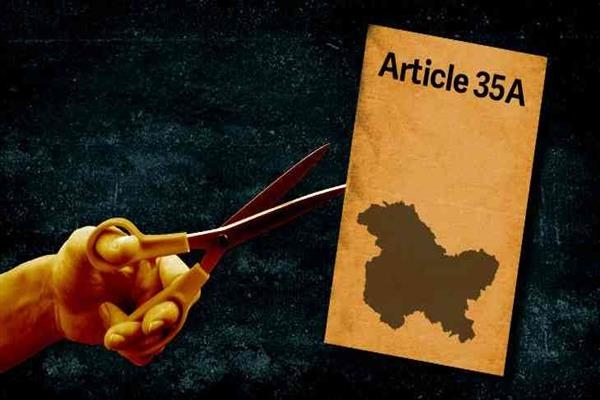First Published on: August 7, 2018
Article 35A as well as Article 370 were inserted into the Constitution in line with the Instrument of Accession.
Kashmir is observing a shut-down today over this challenge to the validity of Article 35A of the Constitution of India. Or, in other words, Kashmir is protesting to protect the Constitution of India. The challenge to this provision has come from a non-governmental organisation (NGO) called ‘We, the Citizens’. Their claim is that the Article is discriminatory, and that the Article 370 of the Constitution – through which Article 35A was inserted – is only temporary and should also be scrapped. The government of Jammu and Kashmir, however, has struck back and in its affidavit, has stated that “the instant petitioner is a busybody, a meddlesome interloper, who has filed the instant petition seeking publicity”.
The affidavit also submitted that the matter had been dealt with in two previous decisions of the Supreme Court, and that the present petition should be dismissed. The first decision was in Puranlal Lakhanpal v. The President of India and Ors.,which was decided in 1961. In this case, Article 35A was specifically challenged on the ground that the President of India had exceededhis powers when he passed the Order inserting the provision. This was not accepted by the Court. The second challenge was in Sampat Prakash v. State of Jammu and Kashmir and Anr.,which was decided in 1968. This matter challenged the President’s powers under Article 370(1) of the Constitution. This Court dismissed the petition in this matter.
What is Article 35A?
Article 35A states:
“Notwithstanding anything contained in this Constitution, no existing law in force in the State of Jammu and Kashmir, and no law hereafter enacted by the Legislature of the State:
- defining the classes of persons who are, or shall be, permanent residents of the State of Jammu and Kashmir; or
- conferring on such permanent residents any special rights and privileges or imposing upon other persons any restrictions as respects—
- employment under the State Government;
- acquisition of immovable property in the State;
- settlement in the State; or
- right to scholarships and such other forms of aid as the State Government may provide,
shall be void on the ground that it is inconsistent with or takes away or abridges any rights conferred on the other citizens of India by any provision of this part.”
In other words, it provides broad powers to the government of Jammu and Kashmir to determine who is a permanent resident, and enables the government to confer privileges on permanent residents while restricting the non-permanent residents.
This provision, in a sense, is a more restrictive version of the Inner Line Permit System (ILPS) that exists in Arunachal Pradesh, Mizoram and Nagaland. The Article was inserted into the Constitution through bypassing the normal legislative procedure. It arose out of the 1952 Delhi Agreement between Jawaharlal Nehru and the then Prime Minister of Jammu and Kashmir, Sheikh Abdullah. This agreement gave Indian citizenship to the people of Jammu and Kashmir. In 1954, then President of India, Rajendra Prasad passed the Constitution (Application to Jammu and Kashmir) Order. Through this Order, Article 35A was inserted.
Ordinarily, the President of India cannot amend the Constitution through Orders. However, Article 370(1) provides for such an exception. Apart from conferring a special status to Jammu and Kashmir, this Article also spells out how the Constitution is to apply to the state. As well as empowering the President to pass Orders regarding how the laws of India will apply to the state. This, in essence, flows from the Instrument of Accession.
What is the Instrument of Accession?
The Instrument of Accession was signed between the then ruler of Jammu and Kashmir, Hari Singh and the Governor General of India, Lord Mountbatten on October 26, 1947. This Instrument provided that the government of India had power over only; defence, external affairs, communications, and elections. The Instrument also stated explicitly that;
“Nothing in this Instrument shall empower the Dominion Legislature to make any law for this State authorizing the compulsory acquisition of land for any purpose, but I hereby undertake that should the Dominion for the purposes of a Dominion law which applies in this State deem it necessary to acquire any land, I will at their request acquire the land at their expense or if the land belongs to me transfer it to them on such terms as may be agreed, or, in default of agreement, determined by an arbitrator to be appointed by the Chief Justice of India.”
This means that the relationship between Jammu and Kashmir and the Union of India is determined by this agreement in the first instance, as well as all other laws that have been passed in furtherance of it.
Thus, if Article 35A or Article 370 were to be repealed, the legal basis for Jammu and Kashmir remaining a part of India too would be extinguished. Though the Indian State is well equipped to prevent any such ‘breaking-away’ through force, the legal basis for retaining Jammu and Kashmir as a part of India would become untenable.
With such heavy implications concerning these provisions, it is no wonder that the CJI would prefer that the matter be heard by all three Judges.
Courtesy: Newsclick.in
